|
T H E M Y T H
"Hold the Vanderbilt, stab the Mail
Annul the Limited, flag the Flyer,
leave the Iroquois in a fix;
This is the World, revealed and true:
Give green to twenty-five and six;
The 20th Century must go through!"
Lucius Beebe
|
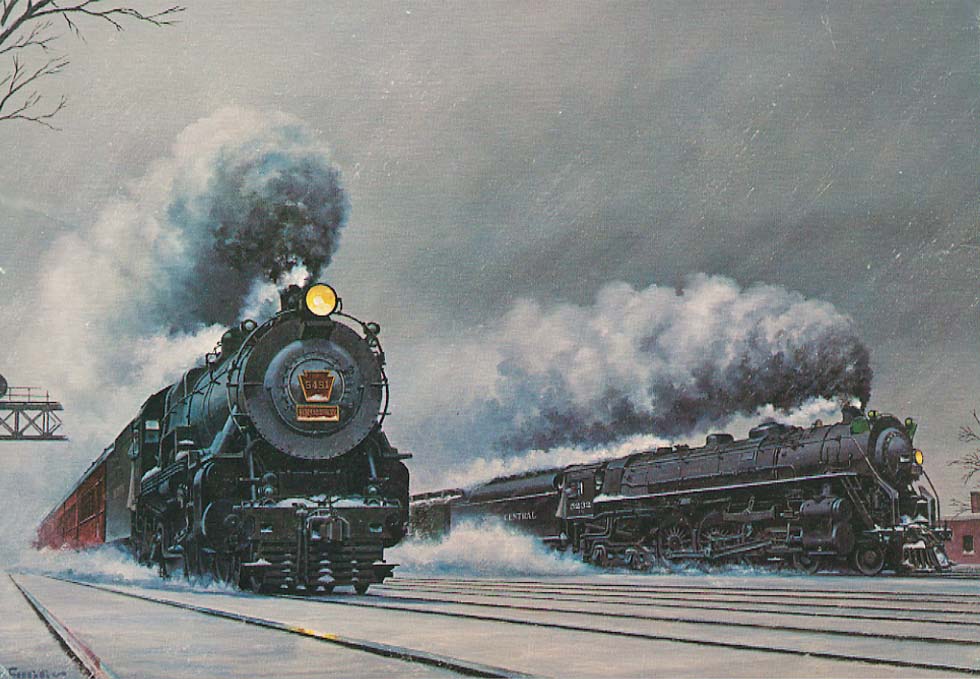
The 20th Century Limited with New York Central's Hudson and Pennsylvania Railroad's Broadway Limited with a K4 Pacific during their great daily race through Chicago's Southside around 1930, a painting by Howard Fogg (coll. Heribert Schroepfer)
This was "The World", New York Central's 20th Century Limited, America's most prominent train, running every night from New York Central Station, world's biggest, to Chicago. Like its competitor, Pennsylvania's "Broadway", it was the best connection for the travelers arriving by Ocean steamers from Europe, which in turn were served by the Ocean Mails from London and the Transatlantiques from Paris…. The Overland, the North Coast Limited, the Empire Builder from Chicago to the West connected with the steamers bound for Japan, New Zealand and Australia, where mail and passengers were carried once again by rail, sometimes by famous expresses to their final destinations. There was also a round-the-world route by the other way, via Suez and the Indian Ocean, served by the "Australian Mail", combined with the "Indian Mail", and by the "Boottreinen "Nederland-Express and Rotterdam Lloyd Rapide in connection with the Dutch steamers to Indonesia. Linking the world by rail was so fascinating, that in the early railway age Kingdom Isambard Brunel, the builder of the epoch's biggest ship, even dreamt of the Atlantic Tunnel. Later the German author Bernhard Kellermann wrote the fiction "Atlantiktunnel" (by the wrong way via the Azores; Scotland - Ireland - Greenland - Canada would have shorter tunnels….).
As the steamers fought for the “Blue Riband”, railways fought for world’s fastest trains. In 1933 it was the “Fliegender Hamburger”, the first really fast diesel railcar, running from Berlin to Hamburg with a speed up to 160km/h. But steam bounced back. On the same track, the dark red streamlined Hudson 05 002 of Borsig, designed by Adolf Wolff and Dr. Lubimoff, attained 200km/h. After the war, when the streamlining of the 05 was removed (once again by Adolf Wolff, now working for Krauss-Maffei), she showed her full beauty.
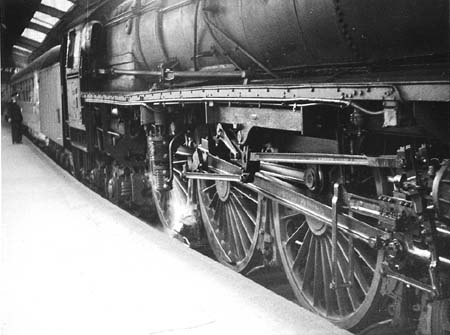
The 05 001, departure at Cologne with a "F" train for
Hannover in 1957 (WS)
|

The French 242.A.1 during test runs Paris - Caen (Raymond Floquet)
|
In England the streamlined A-4 “Mallard” by Sir Nigel Gresley was still a little faster than the German 05, but downhill only (adding more than 1000hp). Really the fastest steam locomotive with at least 141 mph or 226 km/h, was Pennsylvania’s “Big Engine” 6100, a 6-4-4-6, its streamlining being styled by Raymond Loewy. In regular service however, this locomotive with more than 7000hp caused problems, like also its “shark-nosed” smaller 4-4-4-4 sisters T1, due to their duplex-drive layout. In daily service the “A” Atlantics of 1935 and then the F-7 Hudsons of the Milwaukee Road were the fastest ones. With the “Hiawatha” Chicago - Minneapolis they attained around 125 mph or 200 km/h regularly. It was America’s first streamliner, yellow and light gray, designed by Otto H. Kuhler.
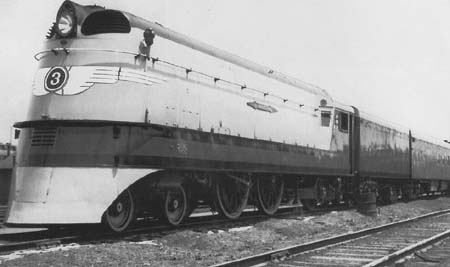
Milwaukee Road class A (coll. Heribert Schroepfer)
|
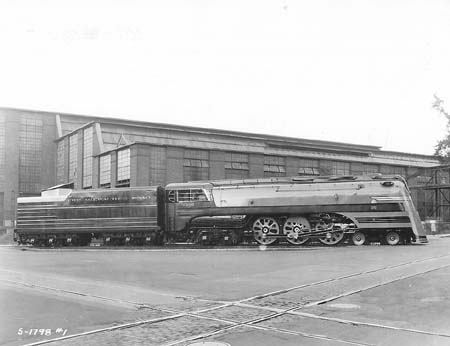
Milwaukee Road class F-7 (Alco)
|
In France the elegance of the steamer "Normandie" was resembled by Etat's "Super Mountain" 241-101 with a three-cylinder engine. After WW II it was rebuilt by Andre Chapelon into the 242.A.1 compound, with more than 5000 horsepower the most powerful steam locomotive of Europe.
In England after WW II very heavy Niagaras were planned, comparable to American locomotives. However, even the new standard Pacific "Duke of York" remained a prototype and the heavier types were not built. In America, higher axle loads and larger dimensions resulted in more power. The higher weight allowed the use of simple-expansion two-cylinder engines, whereas the lighter European locomotives needed three of four cylinders for a smooth ride, resulting in high maintenance costs. And in Europe locomotives were changed every few hours, whilst Santa Fe's oil-fired 4-8-4s did run through from Kansas City to Los Angeles. Also Canada had such highlights, e.g. the 2-10-4 "Selkirks" of the Canadian Pacific or the U-2 Niagaras of the Canadian National, the heaviest express passenger engines in the British Empire. The biggest locomotive ever built was Union Pacific's "Big Boy", a freight Mallet, which also hauled at least some troop expresses. It was created by the engineers Jabbelmann, Ennis and Bruce. Among the single-frame locomotives, Pennsy's Q1 and Q2 4-6-4-4 and 4-4-6-4 prototypes with up to 8000hp at the testbed were the most powerful ones. Though classified as freight engines, they had a Loewy-style semi-streamlining.
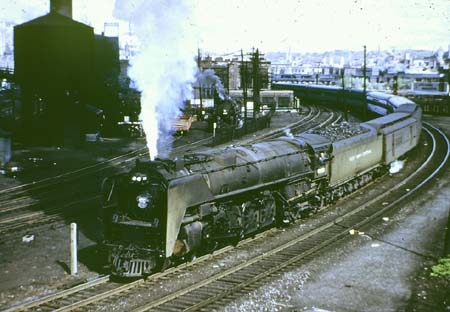
New York Central class S-1 at Albany (coll. Heribert Schroepfer)
|
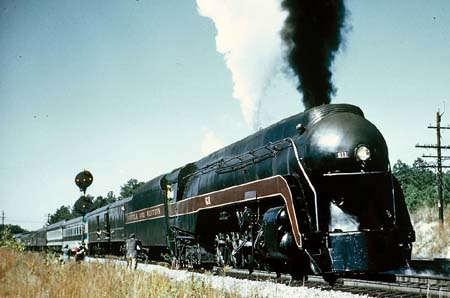
Norfolk & Western class J on a special trip (coll. Heribert Schroepfer)
|
With 6900, later 6500 horsepower in daily service, the most efficient and for many enthusiasts most beautiful express passenger steam locomotive was the S-1b and 2a class Niagara of the New York Central, which hauled the 20th Century Limited before the diesels took over. It had been designed by P.W. Kiefer, a friend of pre-war German locomotive boss Wagner, in the clear German style. They shared the aversion of the complicated compound engine, but Kiefer omitted Wagner's inefficient longboiler. S-1 was rivaled only by Norfolk & Western's class J Niagara, immortalized by the famous photographer Winston Link. With its black semi-streamlining and dark-red ribbon, they resembled "a Krupp's artillery piece", as an enthusiast expressed it. A huge naked black mass is Australia's "Heavy Harry", the biggest Niagara outside North America. And the Pennsy returned to that pure, clear style with the turbine-powered 6200, a gigantic 6-8-6 with more than 7000 horsepower. While experimental turbo-electric steam locomotives failed, the 6200 like also the "Big Engine" and the T1 at least temporarily hauled the prestigious "Broadway". However, it was too late for an economic success.
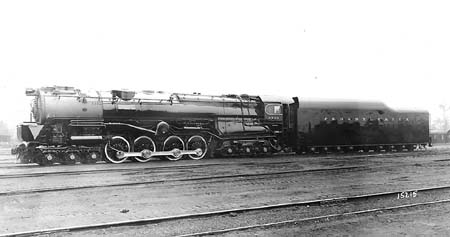
Pennsylvania Railroad's 6200 (Baldwin)
|
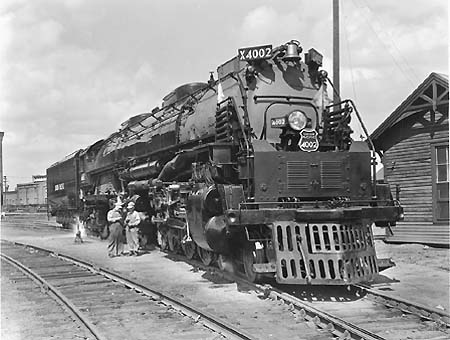
Union Pacific "Big Boy" (UP)
|
The diesels had their victory over steam and Pullman's "battleships", disgusted by Raymond Loewy. The "streamliner" showed to the world the American Way of Life, the yellow "Cities" of the Union and the Southern Pacific and most fashionable one, the Santa Fe "Super Chief", the train of the Hollywood stars, its de-Luxe sleepers in sparkling stainless steel and its two, later four, General Motors diesels, in classic styling by Hamilton, Otter and Meyer, sporting L.A. Knickerbocker's yellow Santa Fe label on the bright red bulldog nose, roaring in 39 ½ hours its way from Chicago to L.A.
For Florida Special and Panama Limited see main chapter Sud-Express
Literature:
A more detailed manuscript in German together with an extensive photo collection by the author is ready.
For more information about England, America and Australia see the excellent literature, about the USA specially the books by Arthur D. Dubin. For the history of the Ocean mail trains in the British Empire, the researches by R. Ellis, J.B. Leitch, N.E. Norman, R. Startup and the competent historical societies, for American locomotive history H.L. Broadbelt, Arnold Haas, Heribert Schroepfer, Joe Thompson and for locomotive lists generally H.J. Wenzel should specially be mentioned. and in 2012 funding for the first section was signed by Governor Jerry Brown. For the history of Ocean passenger shipping see the Web site www.ships-worldwide.com
|